(Above: Art by James Cloutier has taken many forms through the decades, including this piece that, while humorous, nonetheless now conveys an eerily serious and timely message. The original artwork displays a second line below the drawing: Dignity Rules.)
By Randi Bjornstad
The first thing to learn about Eugene artist James Cloutier is how to pronounce his last name.
“You get a choice,” the 82-year-old artist says. “My birth name was Binder (pronounced with a long “i”). My birth father’s parents came from Germany. My parents divorced when I was 5 or 6 or 7, and my mom remarried, to a wonderful man, and he adopted me, and that’s how I became Cloutier.”
His adoptive father pronounced the name Clout EER, “but the farther east you go, the more it changes,” he says. “There are many Cloutiers in Quebec — there’s even a town by that name — where it is Clue tee AY, and then there also are lots in the Cajun areas around New Orleans, but they pronounce it KLU cher.”
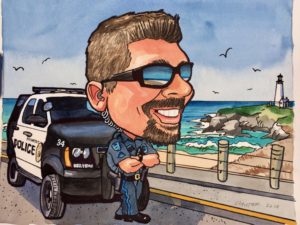
Part of the charm of Cloutier’s caricatures (drawing above) lies in their uncanny resemblance to their originals (photograph below right)
Whatever combination you call James Cloutier, you will call him an artist. He may be best known around Oregon for his whimsically drawn cartoon portraits of Eugene, Portland, and the University of Oregon, each cataloguing buildings, businesses, landmarks, and even personalities in roughly their real locations on the map.
Or you might know him from his commercial art that appears on Euphoria Chocolate Company’s high-end candy bars, among them Dark Chocolate and 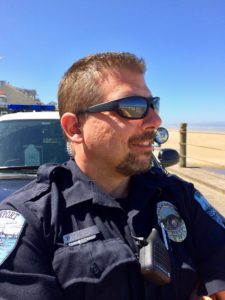 Raspberry Eugene Bar, Milk Chocolate Oregon Bar, Milk Chocolate and Caramel Oregon Coast Bar, and Dark Chocolate Portland Bar.
Raspberry Eugene Bar, Milk Chocolate Oregon Bar, Milk Chocolate and Caramel Oregon Coast Bar, and Dark Chocolate Portland Bar.
Then there was the humorous line of Oregon Ungreeting Cards (“Oregonians don’t tan — they rust”) that he created with business partner Frank Beeson. The pair piggybacked on long-ago Gov. Tom McCall’s exhortations which, among other things, welcomed Californians to come to Oregon as tourists, drop lots of cash during their vacations, and then go back where they came from and leave Oregon in its relatively underpopulated state. Beeson did the quips, Cloutier the drawings.
Later, Cloutier opened a business in downtown Eugene selling art and antiques, created an Oregon-themed coloring book, and produced a series of books of his Oregon-spoofing cartoons.
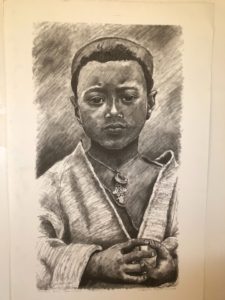
Cloutier’s talent for representing people in art includes fine art representation, as in this portrait; he spent time in Ethiopia during college, building school classrooms, and later served with the Peace Corps in Kenya
Art has been a central part of Cloutier’s life since early childhood.
“I still have my first coloring book, from when I was 3 or 4,” he says. “And I want you to know I could not stay in the lines.”
Although he knew from an early age that he wanted his life’s work to center on art, the path was a bit circuitous.
“I started drawing at about 10 or 11 or 12,” Cloutier recalls. “My mother was encouraging but also critical, but I’m happy that my parents never gave me the facts-of-life talk about the (economic) perils of becoming an artist.”
His mother’s brother, who died by drowning, had been an artist, “and I had a palette that had been his, but I had never seen any of his work,” he says. “But when I was young, I started entering poster contests and winning them, and I became more of an illustrator than a traditional artist — I loved drawing, painting, and caricatures.”
He went to the University of Oregon, graduating with a degree in arts education, “but I did a term of student teaching in a middle school, and I realized that was not what I would be good at,” he says.
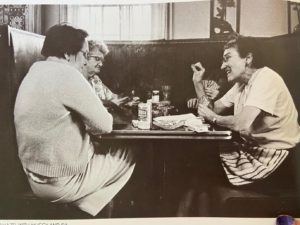
James Cloutier did a book about the Alpine Tavern and its importance as a meeting place for people living in the rural community
At that point, Cloutier steered himself toward photography, which he considered more practical, earning a master’s degree in the subject at the University of Oregon. His master’s thesis was a photo documentary about a rural tavern in the small community of Alpine, west of Monroe in Benton County.
“It was the social gathering place for the town, and when I finished my book, I called it ALPINE OREGON: Photographs of a small town in Oregon,” he recalls. “Then, after a few weeks passed, I began to get feedback from folks in the tavern during my visits that several townspeople thought the book was incorrectly titled. Their reasoning was based on the fact that the majority of images in the book had to do with either the tavern or people who frequented the tavern.”
The more he thought about it, “the more I realized they were right,” he says. So he reprinted the book cover and title page, changing the name to THE ALPINE TAVERN: Photographs of a social gathering place.
It was when he published his book that he went from his identity as Jim Clout EER to James Clue tee AY.
At one point, Clourtier considered trying to pursue photography in New York, and he made a trip there to show his portfolio.
“I had a meeting with a photo editor at the New York Times, and he was encouraging,” Cloutier recalls. “Then I went to the Museum of Modern Art and showed my work to a photo curator and another guy, and they were both really negative.
“The next day, I had an appointment with W. Eugene Smith, who had spent some time (teaching) at the UO. He offered me a glass of gin, looked at my photos, and he was exceedingly complimentary. It was when he was planning his magazine, Sensorium, and he wanted to use some of my images. After that, I left New York feeling vindicated.”
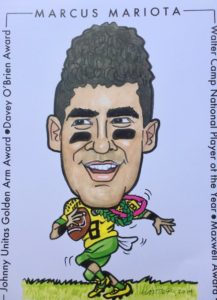
Cloutier’s lifelong interest in sports — after a stint in the U.S. Navy he attended the University of Oregon on a baseball scholarship — came from his adoptive father’s zeal; here he portrays UO quarterback Marcus Mariota.
But it turned out to be his cartooning expertise that really paid the bills, including the cost of printing his book.
“I had found a really good printer for my Alpine photos, but I had to raise the money to pay him, so I found some people here in Eugene who would lend me the money to get my book published,” Cloutier says. “About the same time, I had gone into a bookstore, and the woman who ran it remembered my earlier cartoons and said I should do a book of them. At that point, I only had a couple dozen, but she said I should think about it.”
He did, and the eventual result was a series of books that includes The Best of Orygun (or Learning how to say “Oregon” so everyone won’t think you’re from New Jersey); Orygone, too, (or A nice place to visit but you wouldn’t want to get stuck there); Orygone III, (or Everything you always wanted to know about Oregon, but were afraid to find out); Orygone IV, (or If this is July and it’s raining, this must be Oregon).
Some other Cloutier titles are This Day in Oregon, featuring a character called Hugh Wetshoe; The Unofficial Guide to California; and The Great Texas Joke Book. He also has collaborated with other offers, doing illustrations for children’s books educational materials.
“When I finished my first cartoon book, I had 10,000 copies printed and sold them all in two weeks,” he says. “That was enough to pay all the people who had lent me money to do the Alpine book.”
Cloutier had found his niche.
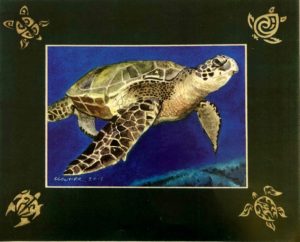
Cloutier’s repertoire even includes detailed wildlife art; he admits there are still other types of art he would like to try, such as painting from nature
Even so, he still would like to try his hand at other forms of art, such as plein air painting, trying to capture a scene while working in nature as light and colors continually change.
“That forces you to go out and work fast and not spend a lot of time on detail,” he says. “That is completely different from the kind of work I have normally done.”
He has created some tongue-in-cheek projects, such as acrylic paintings of Oregon towns with homophonic names — the same pronunciation but different meanings — such as Boring, Riddle, Brothers, Sisters, and Drain.
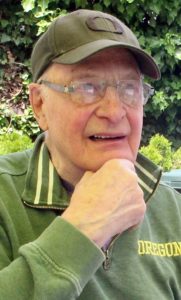
Now 82 years old, James Cloutier always knew he would grow up to be an artist; photo by Randi Bjornstad
“It gave me great pleasure to mix fine art with humor,” he says. “The one of Riddle was especially fun — it was a painting of the main street, with the post office, deli, video store and other businesses, and it incorporated 40 riddles — like the chicken crossing the road — with the riddles on one side, and the answers on the other. I think that one ended up on the wall of a dentist’s office in Riddle.”
The painting of Brothers, of course, included the town, peopled by many sets of famous brothers from history and show business, “and I actually had to update that one later because so many people didn’t recognize all the older brothers any more.”
Nearly all of the original 15 paintings on the homophone theme sold after they were exhibited in a show titled Every Picture Tells a Story at the Alder Art Gallery, run by the late art supporter and gallerist Candy Moffett.
“If I had a grant, I would do them all over again,” Cloutier says. “It was really a lot of fun.”
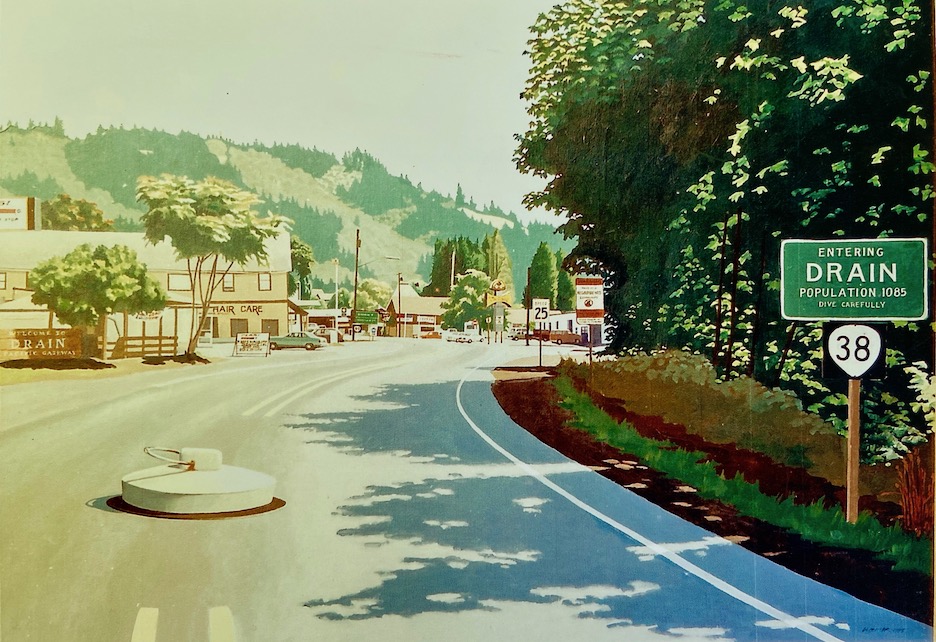
James Cloutier’s tongue-in-cheek portrait of Drain, in northern Douglas County, was part of a play-on-words exhibit featuring Oregon communities.

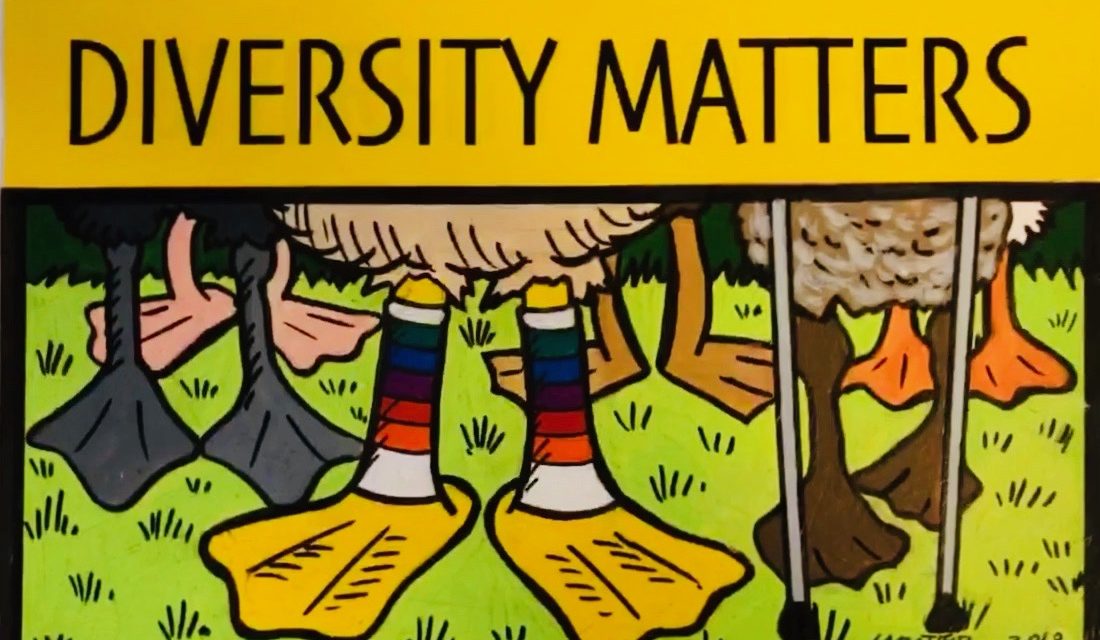
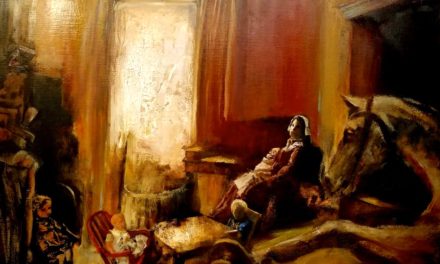
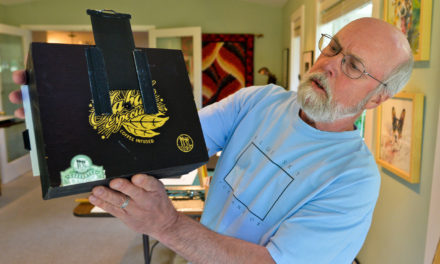
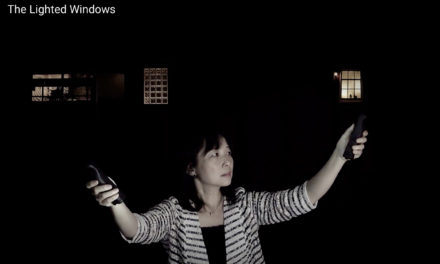
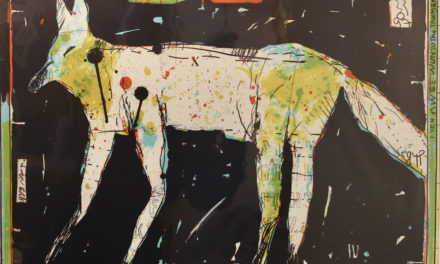



Nice profile, Randi. James is a talented artist and you explain how he honed that talent. Of course, Eugene Smith was right; James is a damn fine photographer. ~ p